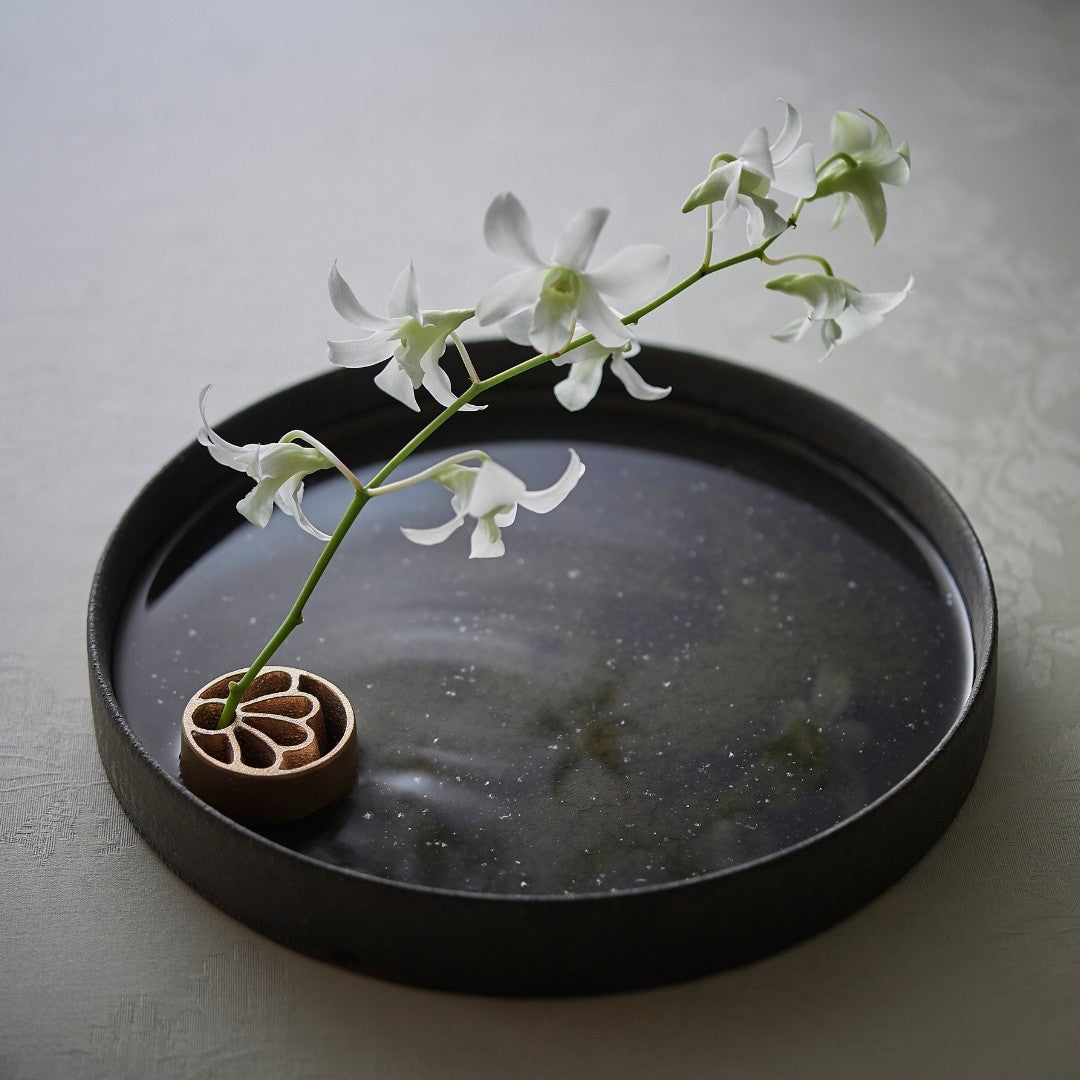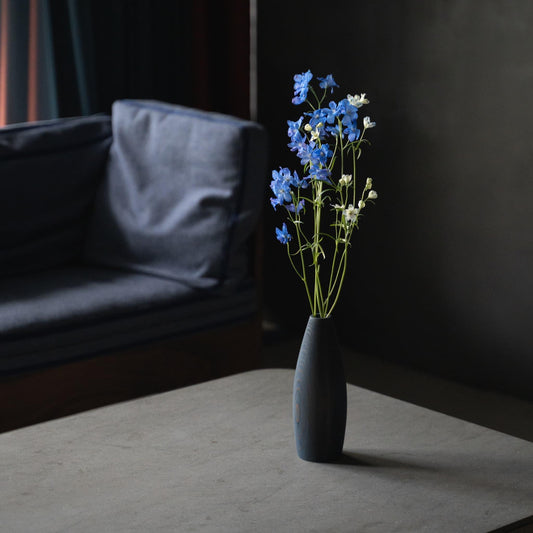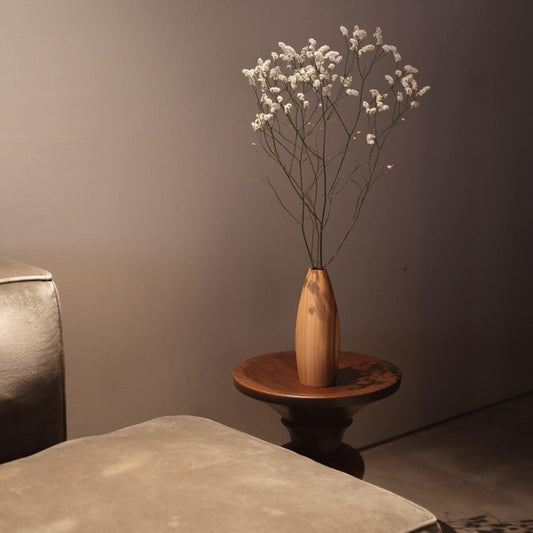
Japanese Flower Arranging: A Beginner’s Guide to Ikebana
Share
Japanese flower arranging (Ikebana) is a unique Japanese art form infused with the spirit of "Zen" and the aesthetic of subtraction. Beyond its role as simple decoration, it offers spiritual richness by allowing you to face your inner self. This article provides a comprehensive guide for beginners living abroad—from historical background to selecting tools and basic techniques—so you can start today. Let’s bring a quiet time of conversing with flowers into your life, away from the hustle and bustle of the everyday.
Table of contents
What is Japanese Ikebana Flower Arranging
Literally, "Ikebana" means "living flowers" or "flowers kept alive"—signifying the act of making the lives of plants shine. Unlike Western decoration, which builds beauty by filling space with flowers, the Ikebana approach observes the inherent "life" and "individuality" of plants to draw them out to the fullest. Using not just vivid petals, but also the curves of branches, the expressions of leaves, and sometimes even withered grass, it condenses nature and the changing seasons into a single vessel.
The essence of Ikebana lies in the handling of "Space." Rather than piling up materials, it prioritizes creating bold "Ma" (Negative Space). This quiet space makes the lines and movement of a single flower stand out, stirring the viewer's imagination. This "Aesthetics of Subtraction" connects to the spirit of Zen and brings deep healing akin to modern Mindfulness during the time spent facing nature in silence.
Furthermore, Ikebana is a "Do" (The Way)—a path of self-cultivation and consideration for others, not just creative art. It encompasses the entire process: settling one's mind before arranging, handling tools with care, and the spirit of "Omotenashi" (Hospitality) toward the viewer. Decorating a single flower in the entryway to welcome a guest sends a silent message: "I have prepared a comfortable space for you." Ikebana is a communication tool that cultivates the heart beyond the pursuit of beauty.
History of Japanese Flower Arrangement
Origins: Prayer to Gods and Nature Worship
The roots of Ikebana trace back to the arrival of Buddhism in the 6th century. The Buddhist custom of "Kuge" (offering flowers before the Buddha) formed the spiritual foundation of flower arranging. At the same time, in Japan's ancient "Shinto" belief, gods were thought to inhabit nature. Rituals involved setting up evergreens as "Yorishiro" (objects where spirits settle), fostering a unique Japanese sensibility that finds sanctity in plants. In this era, flowers were tools for sacred prayer, not merely for viewing.
Establishment of Kado: Architecture and the Birth of Form
In the Muromachi period (14th–16th centuries), flower arranging established its status as the art of "Kado" (The Way of Flowers). This development was deeply connected to the "Shoin-zukuri" architectural style and the birth of the "Tokonoma" (alcove), a special display space. Since the Tokonoma is viewed from the front, flower arrangements required a frontal composition. The monks of the Ikenobo lineage in Kyoto systematized the theory, establishing a foundation that expressed the providence of nature rather than just beautiful decoration.
Luxurious Styles: "Rikka" Expressing Great Nature
In the late 16th century, as samurai warlords seized power, flower arrangements evolved dynamically to match the grand halls of castles. The style perfected during this time is "Rikka" (Standing Flowers). This complex style attempts to reproduce landscapes like mountains and waterfalls, or the order of the universe, within a single vase. Composed of 7 or 9 main branches (Yakushi) standing vertically, this style symbolized the authority of the rulers of that time. Ikebana transcended personal pleasure to become an art requiring high technique and philosophy.
Popularization and Simplicity: the Aesthetics of "Heaven, Earth, Man"
Entering the peaceful Edo period (17th–19th centuries), Ikebana spread from the privileged class to the general public. The "Shoka" (Living Flowers) style was devised as a simple form suitable for the smaller homes of commoners. It consists of three main branches forming an asymmetrical triangle representing "Heaven," "Earth," and "Man." This concept remains widely known abroad as a basic rule of Ikebana today. Many schools emerged, and the publication of manuals solidified its status as a popular hobby.
Evolution to Modernity: Fusion with Western Culture and Free Expression
From the Meiji period (late 19th century) onward, Ikebana underwent dramatic changes under the influence of Western culture. To suit Western-style rooms, the Ohara School invented "Moribana" (Piled Flowers), using shallow bowls (Suiban) and "Kenzan" (flower frogs) to arrange flowers in a spread-out manner. This made Ikebana freer and more colorful. After the war, it developed further as avant-garde art, unconfined by materials or forms. Today, it is a global art form enjoyed worldwide while maintaining its traditional spirituality.
Connection with Zen (Buddhism)
The reason Ikebana is called "Kado" (The Way of Flowers) and established as a path of spiritual training is due to the strong influence of Zen Buddhism. Embodying the Zen teaching of "Mushin" (Clear mind), the time spent arranging flowers becomes a "Moving Meditation" where one clears daily distractions and focuses deeply on the life in front of them. The act of balancing a single flower overlaps with the work of balancing one's own mind; the essential value of this art lies in the process of introspection amidst silence.
Aesthetics of Subtraction and Impermanence The Zen spirit of "Simplicity" and "Tranquility" is reflected in the visual style as the "Aesthetics of Subtraction." By stripping away unnecessary branches and leaves to the limit and utilizing empty space ("Ma"), the vitality of the plant is highlighted. Furthermore, based on the Buddhist teaching of "Mujo" (Impermanence), one finds precious beauty not only in full blooms but also in buds and withering branches. The attitude of accepting the cycles of nature as they are is a deep spirituality cultivated through Ikebana.
Differences from Western Flower Arrangement
The fundamental difference lies in the approach to beauty. While Western flower arrangement is an "Aesthetics of Addition," filling space with colorful flowers, Ikebana is based on the "Aesthetics of Subtraction," removing unnecessary elements to the limit. While Western styles often value volume that fills the space, Ikebana dares to create empty space, or "Ma" (Negative Space). This void is a crucial element that highlights the presence of the flowers and stirs the viewer's imagination.
Composition and material selection also contrast. Western arrangements often favor geometric, symmetrical stability. In contrast, Ikebana pursues asymmetrical balance to express the imperfect beauty found in nature. Additionally, while Western styles focus on blossoms, Ikebana regards branches and leaves—and sometimes withered plants—as important structural elements. A major characteristic is the emphasis on the "Line" and life force possessed by the plant, rather than showing mass and color, to reproduce a natural landscape within the vessel.
Types of Japanese Flower Arranging
There are many schools of Japanese flower arranging, but styles are broadly classified into "Traditional Forms" and "Modern Free Forms." The optimal method differs depending on the vase used, the display location, and the spirituality one wishes to express. Here, we introduce five representative styles beginners should know. Understanding their characteristics will help you find the style that suits you.
Rikka (Standing Flowers)
Rikka is the oldest and most formal style, established in the Muromachi period. It aims to condense and express the landscape of great nature and the harmony of the universe within a single vase. It has a very complex, architectural structure, symbolizing mountains, rivers, and waterfalls with plants. This style is primarily preserved by the Ikenobo school.
Its structure consists of 7 to 9 main branches called "Yakushi," each with strict rules regarding placement and length. While it typically requires high technical skill and spiritual discipline, making it suited for advanced practitioners, its majestic appearance is truly "living sculpture." It is often displayed at traditional Buddhist ceremonies or formal occasions.
Shoka (Living Flowers)
Shoka, established in the Edo period, is a style that expresses the "life force" of plants as they grow from the ground. Simplified compared to Rikka, it reflects the "Aesthetics of Subtraction," utilizing the natural curves and inherent individuality ("Shussho") of the plants to the fullest. It is a foundational style in many schools.
The basic structure consists of three main branches: "Shin," "Soe," and "Tai." These represent the elements of the world—"Heaven," "Earth," and "Man"—and are characterized by drawing a beautiful "Asymmetrical Triangle" when viewed from the front. Though simple, it requires an ultimate sense of balance.
Freestyle
Freestyle allows the arranger to express their sensibility freely, unbound by traditional forms or rules. It evolved to match modern lifestyles and spaces other than the traditional alcove (such as living rooms, offices, or stages). Schools like Sogetsu actively promote this style.
It sometimes combines foreign materials like iron, plastic, or dried driftwood with floral materials, enjoying Ikebana as "Modern Art." Its greatest appeal is that beginners can work on it casually, exercising creativity with a sense of "playing with flowers" without worrying about formalities.
Moribana (Piled Flowers)
This is a relatively new style devised by the Ohara School in the Meiji period to match Western flowers and architecture. It gets its name from piling flowers in a wide-mouthed, shallow container called a "Suiban." It is most suitable for modern housing conditions.
Its defining feature is the use of a "Kenzan" (flower frogs) to fix the flowers. This makes it easier for beginners to secure flowers where they want them, making it ideal for reproducing natural scenery on a table. Rich in color and closest in sensation to Western flower arrangement, it is very popular overseas.
Nageire (Thrown-in Flowers)
Natural Atmosphere: This style involves arranging flowers in a tall vase as if they were thrown in naturally. Without using a Kenzan, it utilizes the natural curves of the stems and their hanging movement, valuing a natural appearance that does not defy gravity. Also called "Heika," it is studied in many schools.
Casual Beauty Supported by Technique: Although it looks casual, it uses techniques such as "Cross-bar fixing" (Jumonji-dome) to secure stems inside the vase. Because it can dynamically enhance a space with few materials, it offers deep expression despite its simplicity.
Hanaisho
This is a new style devised by the Ohara School to harmonize with modern living spaces. It is characterized by its compactness and modernity, suitable for display anywhere, such as on a dining table or shelf. Systematized to be beautiful with few materials, it is an "easy to learn" style most suitable for beginners to learn first.
Basically, there are two forms: the "Rising Form" (Tateru-katachi), where the main stem stands straight, and the "Inclining Form" (Katamukeru-katachi), which tilts to create width. While traditional Ikebana assumes viewing from one direction, Hanaisho allows for compositions that are beautiful from multiple angles and pairs perfectly with modern interiors and colorful Western flowers.
How to Start Japanese Flower Arranging
You might worry, "Doesn't starting Ikebana require years of training?" However, once you grasp the basics, anyone can enjoy it at home starting today. There are two main styles beginners should tackle first. One is "Moribana," using a shallow container (Suiban) and a Kenzan. The other is "Nageire," arranging flowers in a tall vase.
"Nageire," in particular, can be finished stylishly using the natural curves of branches with just a simple cylindrical vase and no special skills. Regarding tools for fixing flowers, "needle-less types" that are safe for beginners have appeared recently, significantly lowering the barrier to entry compared to difficult traditional kenzans. Start by enjoying the time facing the flowers without being too bound by form.
Essential Tools
Ikebana can be started immediately with a basic "vase" and a "kenzan" to fix the flowers. You do not need to gather expensive tools from the start. Here we explain points for choosing tools that are easy for beginners to handle and can be used for a long time.
Ikebana Vase
You don't need to buy expensive specialty vessels immediately. For your first purchase, a "Simple Cylinder Vase" or a "Suiban" (Shallow container) is recommended. A cylinder vase, in particular, fits anywhere and blends well with modern interiors, suiting Western housing conditions.
Cylinder vases are suitable for the "Nageire" style. Choosing a straight design with a mouth that isn't too wide helps stabilize stems with few materials, allowing you to stand branches beautifully without technique. On the other hand, a Suiban is essential for "Moribana," allowing you to express breadth and coolness by showing the water surface. To start, choose white, black, or matte ceramic textures that match any flower.
Ikebana Scissors
First, you need specialized scissors to cut stems and branches cleanly. Japanese "Hasami" are designed differently from general stationery scissors, allowing you to cut thick branches with light force. Sharpness is most important. A clean cut prevents crushing the plant's water-conducting vessels, improving water absorption and making the flowers long-lasting.
Beginners don't need to buy expensive pro tools immediately; gardening shears are a fine substitute. When choosing, check if the size fits your hand and if the material is rust-resistant. The crisp sound of using good scissors becomes part of the ritual of spiritual concentration in Ikebana.
Kenzan (Flower Frog)
Essential for fixing flowers in the intended spot is the "Flower frog." Traditionally used in Japan is the "Kenzan," a metal base with countless needles. While useful for firmly supporting flowers in a Suiban, it can be difficult for beginners, requiring force to pierce thick branches and carrying a risk of injury from the needles.
Therefore, "Needle-less Kenzans" and high-design flower frogs are gaining attention recently. These hold flowers simply by passing stems through brass or stainless steel partitions, damaging flowers less and being easy to maintain. This type is especially recommended for safety in households with children or pets. Starting with tools you find easy to use, rather than sticking to tradition, is the secret to continuing long-term.
How to arrange (Ikebana rules)
Preparation: Mizukiri (Water Cutting)
Always perform "Mizukiri" before arranging. This is a technique of cutting stems underwater in a bowl or bucket. Cutting stems without exposing the cut end to air prevents air from entering the vessels, helping the flower absorb water (Mizusage). This significantly improves the longevity of your work.
Basic Structure: Creating a Scalene Triangle
The basis of Ikebana is composition using three main branches called "Yakushi."
Shin (Main stem): The longest branch, forming the central line of the work. Length should be about 1.5 to 2 times the height of the vase, placed slightly tilted from the vertical.
Soe (Secondary stem): About 3/4 the length of Shin. Placed to support Shin, spreading diagonally.
Tai / Hikae (Supporting stem): About 1/2 to 3/4 the length of Shin. Placed lowest and most forward to tighten the whole composition.
The golden rule is to arrange these so that when the tips of the three branches are connected, they form a "Scalene Triangle" (Asymmetrical Triangle) when viewed from above. Creating asymmetry generates movement and depth.
Finishing:
Jushi (Fillers) Once the skeleton of the three main stems is complete, add shorter flowers or leaves called "Jushi" (fillers) between them. Use them to hide the kenzan or base (Nejime) or to adjust spatial balance. However, it is important not to overfill. Leaving "Ma" (space) highlights a natural beauty as if the wind is passing through. Insert into the kenzan for Moribana, or use the vase rim and inner walls as fulcrums for Nageire to balance.
Tips for Improvement
Sketching: Before you start arranging, draw a simple picture. Just drawing the lines of the vase and branches clarifies the image (composition) of the finished form. Simulating the balance of "Shin-Soe-Tai" on paper allows you to use your scissors without hesitation.
Imitation: When learning on your own, looking at professional photos or textbooks is very effective. Try to copy the shape of a work you like, even if you change the floral materials. Through imitation, you naturally acquire senses for "how to leave Ma" and "angles of branches."
Photography: Always take a picture when your work is finished. Imbalances or shifts in the center of gravity that you don't notice with the naked eye become objectively visible through a photo. Uploading to social media to keep a record is also a good practice for maintaining motivation.
To Enjoy Japanese Flower Arrangement More
Once you understand the basic tools and methods, let's step into the deeper world of Ikebana. Japan has many "Schools," each with its own unique philosophy and aesthetics. Also, knowing the beautiful "Japanese Terminology" associated with flower arranging adds spiritual depth to your work. Here, we introduce knowledge to enrich your Ikebana life.
Ikebana Arrangement Schools
The Three Great Schools: Ikenobo, Ohara, and Sogetsu There are numerous Ikebana schools in Japan, but the "Three Great Schools" have an overwhelming presence in terms of history, scale, and influence. Knowing which style appeals to you is the first step in starting Ikebana. Here we introduce the three most representative schools.
Ikenobo: The Origin of Ikebana
"Ikenobo" is the oldest school in Japan with a history of about 560 years and is considered the "Root" of all Ikebana. It was established by monks in Kyoto during the Muromachi period. Ikenobo's philosophy is to find beauty in the entire transition of plant life—not just beautiful flowers, but also buds, withered branches, and worm-eaten leaves. While inheriting formal styles like traditional "Rikka" and "Shoka," it also incorporates "Freestyle" suited to modern life. It is ideal for those who want to deeply learn "Tradition" and "Spirituality."
Ohara School: Modernizing with Moribana
The "Ohara School" was born in the Meiji period (late 19th century) as Western culture flowed into Japan and lifestyles changed. The founder, Unshin Ohara, devised the innovative "Moribana" style, using Western flowers and piling them in a wide-mouthed shallow container (Suiban). It was at this time that the "Kenzan" was introduced to fix flowers. It excels at landscape depictions that fit modern homes and Western-style rooms, characterized by an accessibility that reproduces natural scenery on a table.
Sogetsu School: Free Expression and Art
Founded in 1927 by Sofu Teshigawara, "Sogetsu" is the newest and most avant-garde of the major schools. Against the conventional Ikebana that valued "Form," it proclaimed the free philosophy of "Anytime, anywhere, by anyone." It does not hesitate to use foreign materials like iron, stone, or plastic in addition to plants, treating Ikebana as "Modern Art" expressing individuality. It is loved by artistically minded people who want to exercise free creativity unbound by rules.
Japanese Terms Used in Ikebana
Words Related to Space and Composition
Ma (Negative Space): This refers to the space "between things," but it is not merely an "empty place." It contains atmosphere, presence, and tension. In Ikebana, the empty parts (Space) without flowers are considered as important as the parts with flowers to achieve overall harmony.
Yohaku (Empty Space): Similar to "Ma," but refers to space left open more physically and boldly. By not filling the view and daring to leave parts empty, it stirs the viewer's imagination and allows them to feel a lingering resonance ("Aftertaste").
Hikizan no Bi (Aesthetics of Subtraction): While Western decoration is often an "Addition" of elements, Japanese beauty is a "Subtraction" that strips away unnecessary things to the limit. Leaving only the truly necessary branches and flowers highlights their essential beauty.
Words Related to Aesthetics and Spirituality
Wabi-Sabi: A heart that finds profound beauty in things that are incomplete, simple, and aged over time. It cherishes the quiet flavor found in withered branches or bent stems rather than flashy beauty.
Mujo (Impermanence): The Buddhist concept that "all things are transient." Flowers bloom and eventually scatter. Ikebana captures that fleeting moment of life and expresses a heart that accepts change.
Ichigo-ichie (Once-in-a-lifetime encounter): A term from the spirit of tea ceremony meaning "this meeting happens only once in a lifetime." It is the mindset of cherishing the encounter with flowers that will never take the same shape twice, and the time shared with those who view the work.
Words Related to Atmosphere and Dignity
Iki (Chic): Being refined and sophisticated. It includes a coolness that shows dedication effortlessly, combining tradition with modern smartness.
Yugen (Subtle Grace): A deep, mysterious beauty that cannot be fully expressed in words. It refers to a sensibility that feels the presence and lingering emotion behind what is clearly visible.
Miyabi (Elegance): Graceful and refined beauty like that of court culture. It prioritizes sophisticated taste and dignity within gorgeousness.
In the world of Japanese flower arranging, you can feel the breath of nature expanding within a single flower. Do not overthink it. First, prepare your favorite vase and seasonal flowers, and trust your own sensibility to arrange them. What matters is the process of facing the flower itself, rather than creating a perfect form. That quiet time brings deep peace and color to your daily life. Now, let’s start your own unique Ikebana life today.









































